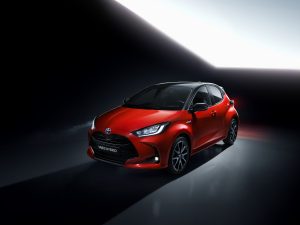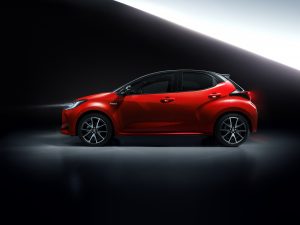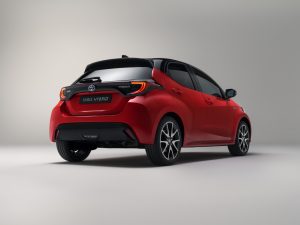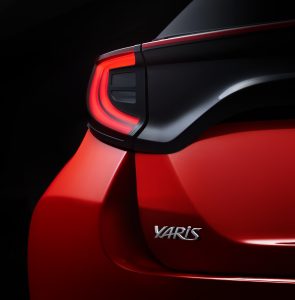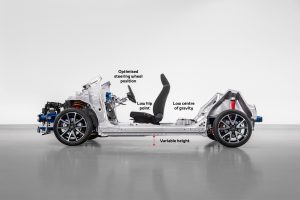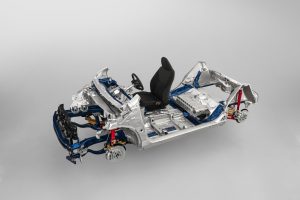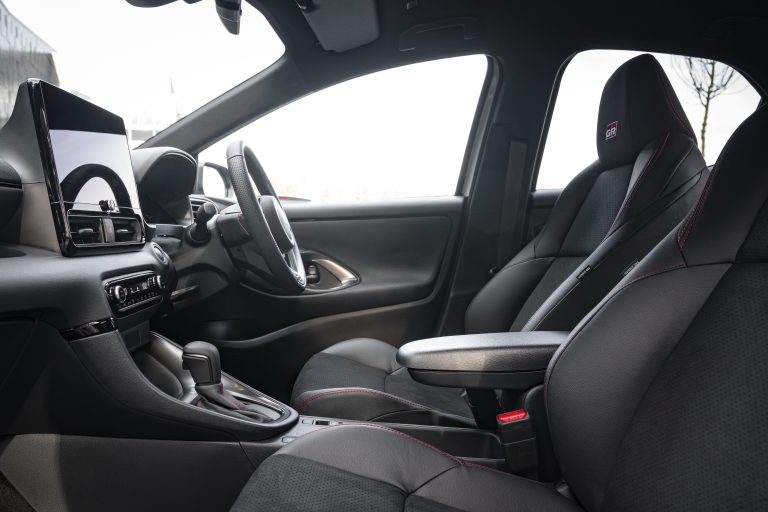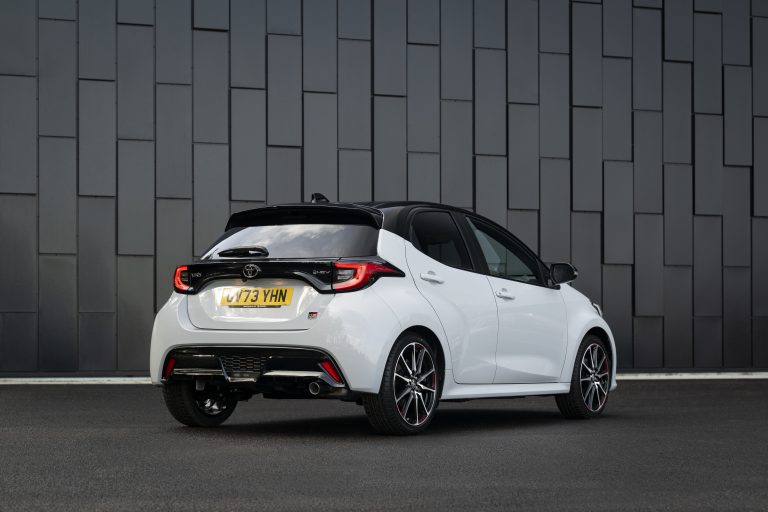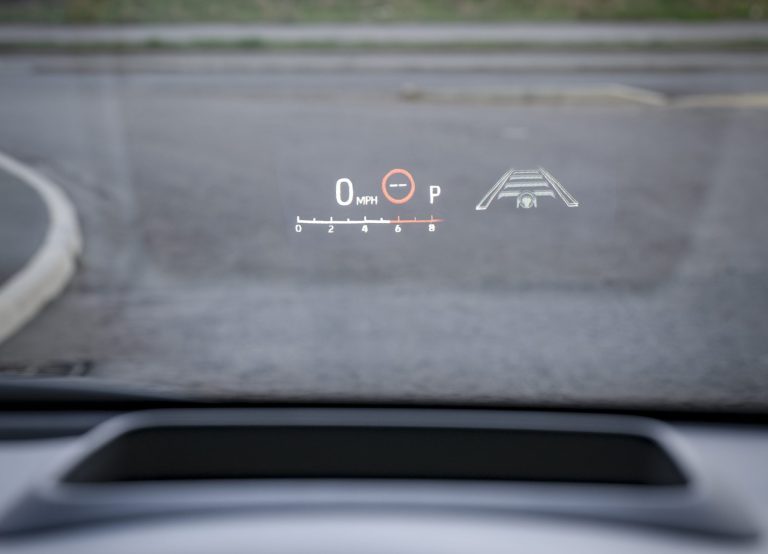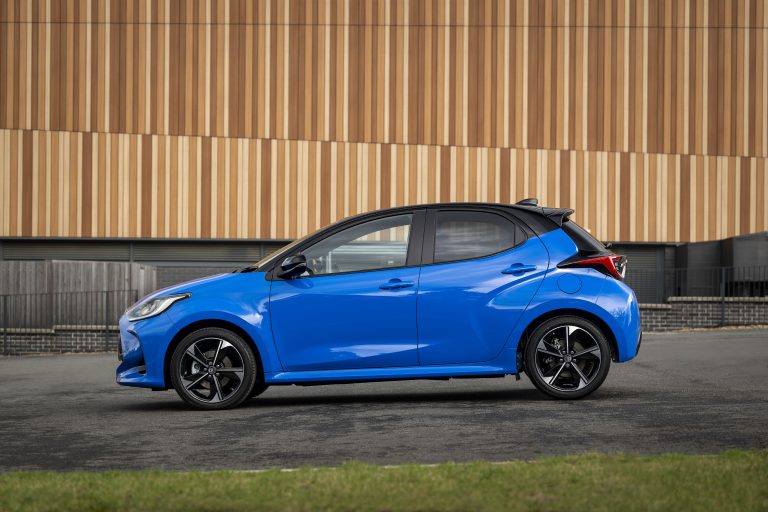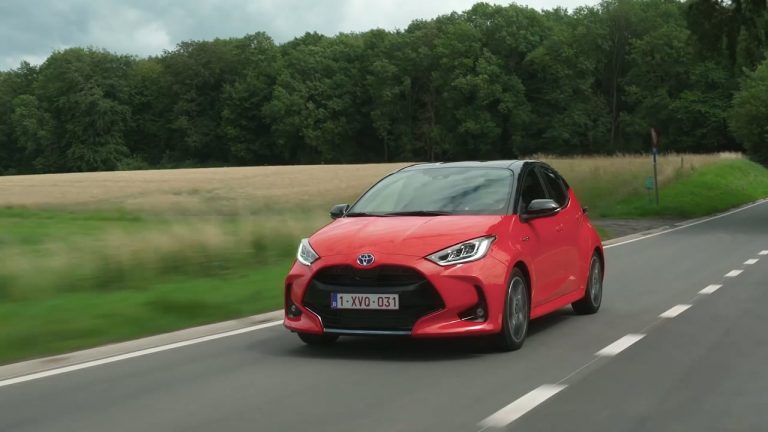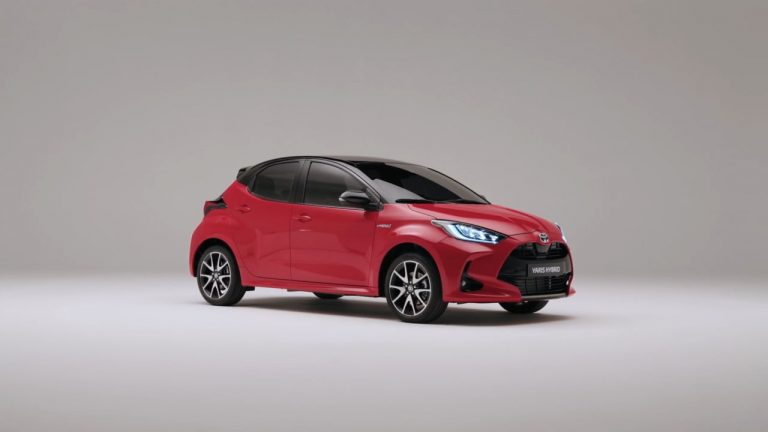The New Toyota Yaris: Designed for Urban Life
- First application of Toyota New Global Architecture (TNGA) in a compact car
- New GA-B platform delivers style, practicality, driving enjoyment and safety
- New 1.5-litre hybrid system blends high efficiency with improved response
- Engineered to be the world’s safest compact car
- New Yaris to be introduced in second half of 2020, details of UK range, specifications and pricing to be announced nearer the on-sale date
The all-new Toyota Yaris renews the model’s reputation for ground-breaking achievements. Due for launch during the second half of 2020, it will strengthen its position as Toyota’s best-selling model in Europe, benefiting from significant advances in design and engineering.
The new Yaris is the first model to be built on the Toyota New Global Architecture (TNGA) GA-B modular platform for small cars. This is the foundation for radically improved dynamic performance, safety and design freedom of the kind already witnessed in other TNGA-based Toyota models, such as the new Corolla, Toyota C-HR and RAV4.
In every aspect, it responds directly to the needs and preferences of today’s compact car customers: sharp styling, great manoeuvrability, excellent cost-of-ownership, comfort, quality and the clever application of new technologies, including multimedia functions and a new hybrid powertrain.
Yaris was the first car in its class to offer customers the choice of self-charging hybrid power; now it builds on that reputation with a new 1.5-litre hybrid system, featuring a new three-cylinder 1.5-litre petrol engine that delivers even greater efficiency – low CO2 emissions, improved fuel economy and, as a full hybrid, the ability to run on electric power alone.
Details of the UK model range, technical and equipment specifications and prices will be announced in 2020, nearer the on-sale date.
OVERVIEW
The all new Toyota Yaris has been designed to meet the increasing challenges of everyday urban life.
Today’s compact car customers are among Europe’s most demanding, people who typically lead busy lives and have to deal day-to-day with ever-more congested urban environments.
They expect their car .to deliver style and practicality. They want it to be easy to park, agile in the city and comfortable on longer journeys. They expect leading levels of safety and the lowest possible running costs. They are also more environmentally aware than ever before.
And, of course, they prefer these attributes to be delivered at an affordable price.
To respond to these demands, the new Yaris brings Toyota’s TNGA philosophy to the compact car segment for the first time. It is the first model to use Toyota’s new GA-B platform, and the first to use its new TNGA three-cylinder, fourth generation self-charging hybrid system.
This approach is complemented by advances in active and passive systems to create the world’s safest compact car.
NEW GA-B PLATFORM ENABLES STYLISH DESIGN AND SMART PACKAGING
- Powerful, taut exterior design expresses agility and compactness
- Shorter, wider and lower than the current Yaris model
- Intelligent packaging maximises interior space
- Materials innovation and a new level of sensory quality
The new Yaris’s exterior design concept is defined as “Condensed and Agile” – always ready to move and be enjoyed.
Its “condensed” dimensions set it apart in a market segment where new cars have typically grown larger with each successive iteration. Counter to this trend, Toyota has reduced Yaris’s overall length by 5mm, but at the same time increased its wheelbase by 50mm, ensuring the car is agile and manoeuvrable in city driving and parking, but has a comfortable and roomy interior – the essence of its “big-small” character.
The GA-B platform has enabled a 40mm reduction in the overall height, but headroom has not been compromised, as the driver and passengers sit lower in the car. The reduced cowl height contributes to a better forward view for the driver. Adding 50mm to the car’s width generates more space in the front and in the rear, while the wider front and rear track widths add to new Yaris’s lower, wider look.
The exterior styling amplifies the effect of the condensed proportions with strong character lines down the side of the car that project a sense of forward motion. Powerful front and rear wings add to the overall taut, coherent look and, together with the sculpted door panels, express a sense of agility and the car’s “ready-to-go” character.
The frontal design focuses on the large grille and the central Toyota emblem. By pulling the base of the A-pillar rearwards and increasing the bonnet length, the designers have added to the dynamic look. The new lights feature LED technology and include turn indicators that alternate with the daytime running lights. The headlights extend towards the front wheels in a strong styling feature that also reduces the perceived length of the front overhang.
The interior design follows a “less-is-more” principle, creating an open and spacious area for the driver and front passenger. High-quality materials include an innovative felt trim finish for the door panels and, for the first time in a Yaris, a soft-touch instrument panel to create a warmer cabin ambience.
Throughout, sensory quality has been a key focus point, in terms of the touch, operation and sound of the controls, colours, illumination, shapes, patterns, graphics and overall appearance.
The cockpit design has been developed around the concept of “hands on the wheel, eyes on the road”. Information is presented clearly and directly to the driver from three interlinked sources: the central Toyota Touch touchscreen, a TFT multi-information display in the instrument binnacle and a 10-inch colour head-up display. The larger size head-up display helps the driver focus on the business of driving with least distraction. It projects key driving data and warnings, such as navigation prompts and speed limits, onto the windscreen within the driver’s field of view.
The ergonomic design makes controls intuitive to locate and use, while the dashboard itself has been made slimmer and is set lower, with a wider and higher centre console. The driver’s instrument binnacle has twin digital meters flanking the TFT multi-information display, and is presented with just a shallow hood. Last, but not least, the steering wheel size has been reduced for better visibility supporting the “eyes on the road, hands on the wheel” concept.
GA-B PLATFORM ENGINEERED TO DELIVER DRIVING ENJOYMENT
- The basis for a confident and natural drive with accurate and agile performance
- Low centre of gravity and optimised driving position
- High rigidity body contributes to handling and stability performance
Toyota’s development of TNGA-based platforms has delivered a step-change in the ride, handling and styling of a series of new models. The first, the GA-C mid-size car platform, was the foundation for advances in the driving character and appeal of the latest generation Prius, the Toyota C-HR and the new Corolla. Similarly, the TNGA philosophy has demonstrated its adaptability for larger saloons and SUVs, with the GA-K platform underpinning the new Camry and the new RAV4 to great effect.
Now, with the development of new Yaris, Toyota is applying the power of TNGA to elevate its compact car performance for the first time. The GA-B platform is central to the new Yaris’s enhanced driving enjoyment. The car’s stability inspires confidence, while its response to the driver’s inputs is natural and precise, leading to a heightened sense of agility.
The combination of new Yaris’s compact, low and wide dimensions, the dynamic qualities of the GA-B platform and the performance of the fourth generation hybrid powertrain creates an engaging and agile character that is a key part of the model’s emotional appeal. Around town it delivers an engaging and crisp response; at the same time, performance and handling deliver the kind of smooth and relaxing drive that’s comfortable and desirable when making longer motorway journeys or cruising on the open road.
As with other TNGA-based models, the driver’s sense of control and connection with the car is enhanced by their position at the wheel. The GA-B platform allows the driver’s seat to be set lower and further back (+60mm compared to the current Yaris) towards the centre of the car, helping bring down the vehicle’s centre of gravity. It also creates a more engaging driving position, with improved ergonomics and greater adjustability. The steering wheel is set closer to the driver, with a six-degree increase in the tilt angle.
As in all TNGA-based models, the centre of gravity is low, around 15mm lower than on the current model, giving the car better inertia characteristics. The chassis also has a better weight balance, both front/rear and left/right, which reduces body roll and improves braking stability and stopping distances, while the body’s improved torsional rigidity contributes to the car’s agile and stable handling.
The new front MacPherson strut and rear torsion beam suspension designs include reduced friction in the front struts, softer springs and an increase in rear roll stiffness from 320 to 580Nm/deg, which further improve the new Yaris’s dynamic qualities, reducing body roll in cornering and increasing agility.
The GA-B platform has allowed for a significant increase in body rigidity, which fosters vehicle stability and ride comfort, together with lower noise and vibration levels. The platform’s architecture and the upper body have been optimised, with strategic reinforcements in the cowl, rear pillar, tunnel and rear structure and the rear wheelhouse, and a stiffer dashboard panel.
NEW 1.5 HYBRID POWERTRAIN: MORE RESPONSIVE AND MORE EFFICIENT
- All-new 1.5-litre hybrid powertrain
- More responsive with a 15 per cent increase in combined power (engine and electric motor) and a more than 20 per cent increase in fuel efficiency
- Fourth generation hybrid technology optimised for weight, packaging and efficiency
- System includes new 1.5-litre petrol engine with 40 per cent thermal efficiency
Toyota’s leadership in self-charging hybrid technology is built on more than 20 years’ experience. Toyota hybrid vehicles have proved their outstanding quality, durability and reliability, collectively covering more than half a billion kilometres around the world every day.
Since the introduction of the first Prius back in 1997, Toyota Motor Corporation has sold more than 14 million hybrid vehicles worldwide – including 2.5 million in Europe. It has constantly improved the technology and progressively introduced new models across a wide range of market segments. Yaris Hybrid, the world’s first full hybrid B-segment model, was introduced in 2012, since when more than half a million have been sold in Europe, establishing it as a key product in creating wider public awareness and appreciation of the benefits of Toyota’s hybrid technology.
The fourth generation Hybrid system has been tested in different cities around Europe, including Rome, Paris, and Darmstadt. Results from these real-world trials show that when operating in urban areas, cars equipped with the technology operate for 80 per cent of the journey time as a Zero Emission Vehicle.
These outstanding results are made possible by the architecture of Toyota Hybrid System. This basically contains all the elements of an electric car, such as high-power motors and high-voltage components, together with a highly efficient engine (running on the Atkinson cycle).
Toyota’s fourth generation hybrid technology makes its debut in the principal powertrain for the new Yaris. This 1.5 hybrid system is directly derived from the larger, 2.0 and 2.5-litre systems that were introduced in the past year in the new Corolla, RAV4 and Camry models and has been developed with the same level of scrutiny of component size and weight in the quest for ever-better fuel and emissions efficiency.
The hybrid system features Toyota’s new 1.5-litre three-cylinder Atkinson cycle petrol engine with variable valve-timing. As with its four-cylinder 2.0 and 2.5-litre counterparts, it benefits from detailed measures to reduce internal friction and mechanical losses and optimise combustion performance. In fact, the engine has the world’s fastest combustion speed, supporting high torque at low engine speeds and fuel efficiency. It is also fitted with a balance module, which helps reduce engine noise and vibration.
As a result, it achieves 40 per cent thermal efficiency, higher than comparable diesel engines, helping secure an improvement of more than 20 per cent in Yaris’s fuel economy and CO2 emissions. At the same time, system output has been increased by 15 per cent and power delivery has been refined to give a confident and natural driving feel.
The hybrid transaxle has been fully redesigned, adopting a new dual axis structure that makes it more compact (by nine per cent). The result is a low-loss geartrain with smaller overall dimensions that improves performance and is comfortably packaged within the new GA-B platform.
The system also uses a new lithium-ion hybrid battery, giving increased output that enables quicker vehicle acceleration. As well as being more powerful, the battery is 27 per cent lighter than the nickel-metal hydride battery it replaces.
In selected markets, the new Yaris will also be available with 1.5 and 1.0-litre three-cylinder petrol engines. More details of these powertrains will be released at a later date.
A NEW LEVEL OF ADVANCED DRIVER ASSISTANCE SYSTEMS FOR COMPACT CARS
- Designed to be the world’s safest compact car
- Developed for leading active safety performance with new Toyota Safety Sense (TSS)
- First car in its class to feature a centre airbag
The new Yaris is designed to be the world’s safest compact car, featuring significant advances in both active and passive safety systems. The aim is to give people the best possible safety protection in their daily drives.
Advanced driver assistance systems include full speed-range intelligent adaptive cruise control and lane trace assist, as featured in the recently launched new Toyota Corolla. These features are fitted as standard on every new Yaris.
In addition to these systems, the new Yaris has been developed to provide the best possible occupant protection, in line with stricter testing standards that will be applied in 2020. For example, to provide protection in the event of a side impact, Yaris will be the first car in its segment to be fitted with a centre airbag.
Full details of the new Yaris’s active and passive safety systems will be released at a later date.
YARIS – A EUROPEAN SUCCESS STORY DRIVEN BY INNOVATION
Yaris is at the heart of Toyota’s European success story, a model which has enjoyed sustained popularity and an excellent reputation for consistent innovation.
The original Yaris made an immediate impact, earning both the 2000 European Car of the Year honour and an Engine of the Year award for the ground-breaking performance of its 1.0-litre petrol engine. The first Toyota to be designed specifically for Europe, it has also been manufactured here, at Toyota’s facility in Valenciennes, France, since 2001.
The second generation Yaris had the distinction in 2005 of being the first car in the B-segment to achieve a top five-star safety rating in the independent Euro NCAP test programme, and was the first car in its class to be fitted with driver’s knee airbag.
In 2012, the third generation Yaris became the first model in its segment to be equipped with a self-charging, full hybrid powertrain, setting new benchmarks for fuel economy and emissions performance.
In 2017, Toyota re-entered the World Rally Championship with the Yaris WRC, inspiring development of the performance-focused Yaris GRMN road car. Drawing directly on the competition success of Toyota Gazoo Racing, this limited-edition Yaris – the first global GRMN model – was an instant sell-out.
This history of innovation has helped Yaris grow from generation to generation, with more than four million sold in Europe, including more than 500,000 hybrids.
The new, fourth generation Yaris marks the debut of the Toyota New Global Architecture (TNGA) GA-B platform that will be used for new generations of small Toyota vehicles and their derivatives. It will continue to be manufactured in Europe; more than €300 million (around £270 million) has been invested in Toyota Motor Manufacturing France’s operations to enable GA-B-based vehicle production.
ENDS

